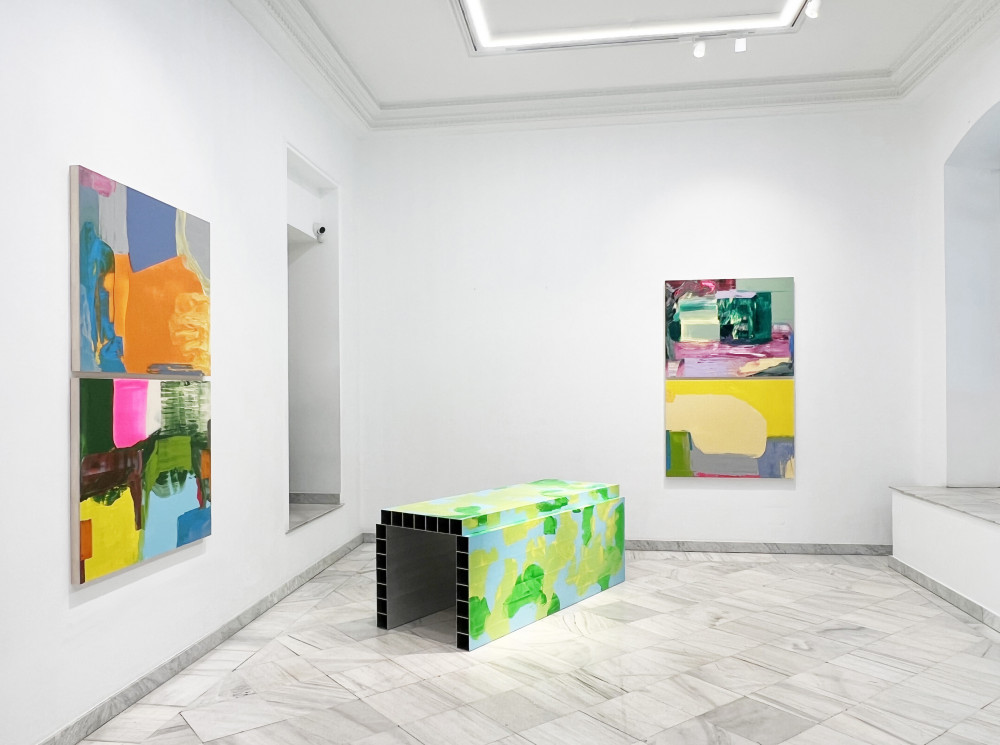
PEDRO CALAPEZ. Guide to Possible Worlds
26 Oct - 11 Dec 2023
The Fernando Pradilla Gallery presents in our halls the second individual exhibition of the Portuguese artist Pedro Calapez (Lisboa, 1953). Under the title Guide to Possible Worlds [Guía de mundos posibles] he has gathered a range of works where painting remains the essential foundation of his aesthetic proposal, uniting research and praxis in a work invaded by with literary, architectural, and plastic references, and impregnated by reverberations that bring his work to the artistic movements that have set the tone for abstract painting in the second half of the 20th century. Abstract expressionism, fields of colour, support surface, expanded painting are conceptual contexts where the work of Calapez has found a fruitful context to develop an oeuvre attracted by spatiality, which engages in a dialogue with the space of exhibition, which promulgates a kind of landscape of dematerialization and calls for an active perception of the artistic object. In this context, Calapez asserts in an interview that, “When I place a succession of masses of colour upon a surface, that surface goes on to search an abstract penchant, undoing the traditional representation of reality, accepting the traditional representation of reality, and assuming a certain gestuality; while at the same time compelling the spectator to coursing a parallel world of reflections about those same processes. The explicit opposition between industrial materials and fine arts materials, or the deconstruction of the visual plane towards a multiplicity of planes, harkens back to reflections such as those of Deleuze in the 1980s, regarding the concept of repetition and the construction of memory.” P.C.
The central body of work from the exhibition Guide to Possible Worlds is made up of four paintings on canvas boards composed as large-size diptychs. The diptychs, in their dual, fragmented, and univocal quality, share at the same time their undivided nature, and rise out in those worlds through which Calapez leads the spectator, and himself, in a kind of itinerary whose intention is to “maintain the bewilderment and questioning over the visual object on display, spurring the spectator to discover certain relations in the work itself or in its particular arrangement and in the elements that constitute it; which is only possible with a careful discovery of the space on the part of the viewer.” P.C.
In his review of this new exhibition project, Calapez returns to the literary world that inspires his work: “Brief was the image, which vanishes quickly in the book El Suplicio de Tántalo, hidden between my father’s books. In the cover there is a drawing of two bodies, a woman and a man, naked, tied the one against the other, their backs to the viewer. I grabbed the book, but didn’t read it, nor can I remember the author’s name. The image on the cover, in gray tones like a black-and-white photograph of a sculpture, was enough to push me toward unforeseen and innovative sensations. I don’t know if the origin of the diptychs—paintings which emerge from within the canvas—is finally there: two bodies, two panels, which try to exchange looks, though their eyes never meet. Only a gaze outside of the surface can be able to understand and perceive how for the colours and forms of both paintings complement each other.”
Pedro Calapez has a BA in Fine Arts, majoring in Painting, from the University of Fine Arts of Lisbon. His first exhibitions date from the 1970s, and in 1982 he made his first solo exhibition. He has shown his work in multiple institutions, including Casa de la Cittá, Rome; Carré des Arts, Paris; Gulbenkian Foundation, Lisbon; Salpêtrière Chapel, Paris; Chiado Museum, Lisbon; Pilar i Joan Miró foundation, Mallorca; Studiolo, Witten, Germany; Museum of Contemporary Art (MEIAC), Badajoz; Andalusian Contemporary Art Centre (CAAC), Seville; Galician Centre of Contemporary Art (CGAC), Santiago de Compostela; Caja de Burgos Art Centre (CAB), Burgos; Center of Visual Arts (CAV), Coimbra; Contemporary Art Center Casa da Cercas, Almada; Fundaçao PLMJ, Lisbon; Paula Rego Foundation , Cascais; Luis Seoane Foundation, La Coruña; Carmona e Costa Foundation, Lisbon.
Pedro Calapez’s oeuvre has shown his work in the Venice Biennale in 1986, and in two editions of the São Paulo Biennale (1987 and 1991). At the same time, he has participated in numerous group exhibitions in a number of exhibition spaces: PMMK Museum, Ostend; Serralves Museum, Porto; Berardo Museum, Lisbon; Barrié Foundation, A Coruña; Cercle Cité, Luxemburg; Pilar Citoler Collection, Convent de Sant Domingo, Pollença, España; Sismógrafo, Porto; Eugénio de Almeida Foundation, Évora. In the last two years (2022-2023) he has shown his work in the Nadir Alfonso Museum, Chaves; National Museum Soares dos Reis, Port; and in the Museum of Art, Architecture and Technology (MAAT Central), Lisbon, among many others.
His works are part of important public and private collections, among them: CGD-Caixa Geral de Depósitos, Lisbon; Art Center CAB-Caja Burgos, Burgos; Central European Bank, Frankfurt; CGAC-Galician Centre of Contemporary Art, Santiago de Compostela; Chase Bank N.A, Nueva York; Cachola Collection, Elvas; European Investment Bank, Luxemburg; Coca-Cola España Foundation, Madrid; Prosegur Foundation, Madrid / Lisbon; Pilar y Joan Miró Foundation, Mallorca; Gulbenkian Foundation, Lisbon; Fundación EDP, Lisbon; Fundação Luso-Americana, Lisbon; PLMJ Foundation, Lisbon; Telecom Portugal Foundation, Lisbon; MEIAC-Museo Iberoamericano de Arte Contemporáneo, Badajoz; MNCARS-Queen Sofia National Museum Art Centre, Madrid; Serralves Museum, Porto; Seippel Collection, Colonia, entre otras.














